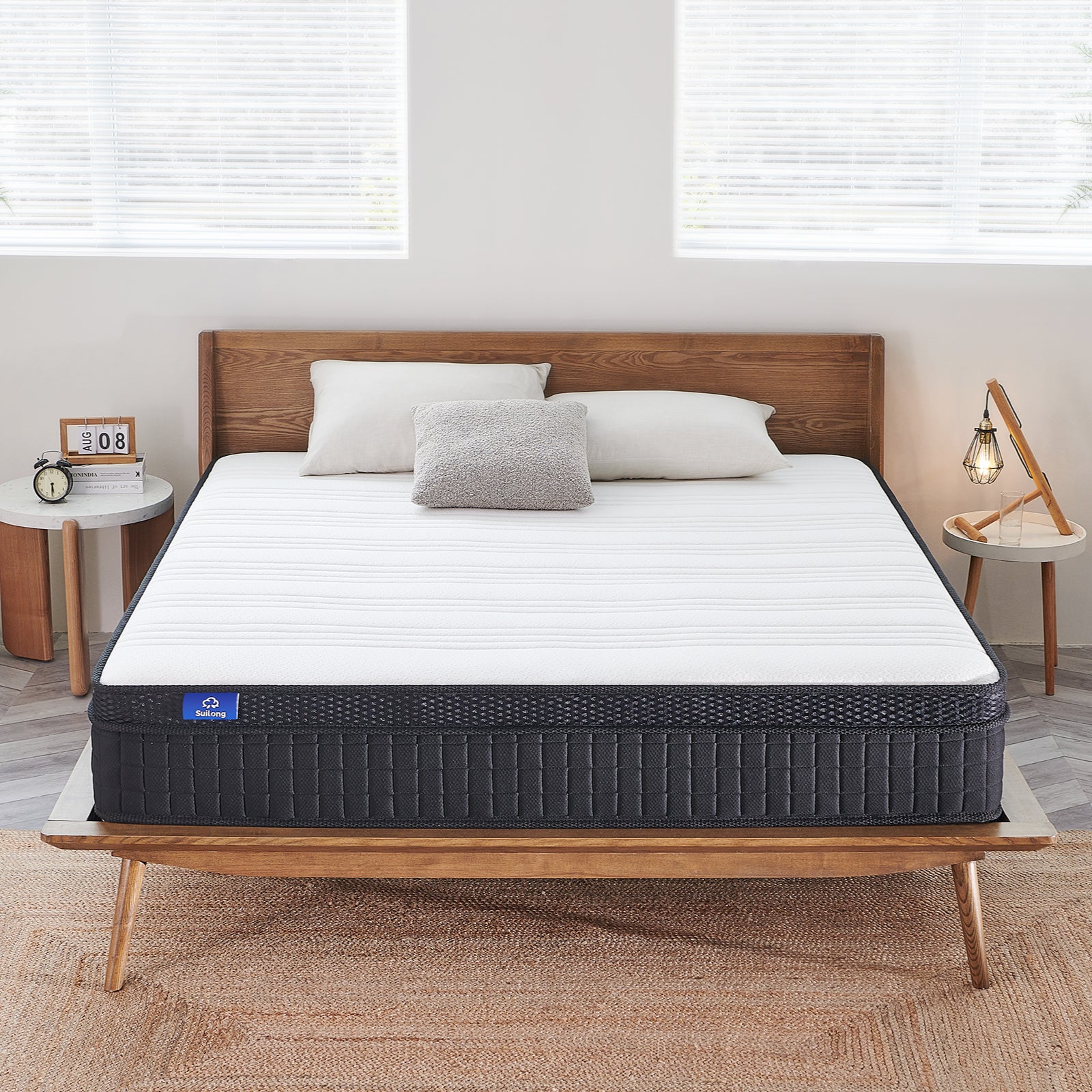Do Memory Foam Mattresses Need Box Springs?

Explore whether memory foam mattresses need box springs in our comprehensive guide, offering expert advice on bed frames, maintenance tips, and comfort comparisons. Ideal for informed mattress shopping.
1. Exploration of spring bed frames with memory foam mattresses
Basic Functions and Advantages and Disadvantages of Spring Bed Frame
Spring bed frames are popular for their sturdiness and durability. Traditional spring bed frames provide firm support for mattresses, ensuring that they do not sink or warp. However, spring bed frames can also cause some mattresses, especially memory foam mattresses, to over-compress, which can affect comfort and longevity.
Effect of spring bed frames on memory foam mattresses
Memory foam mattresses are designed to evenly distribute weight and reduce pressure points. When this type of mattress is used with an innerspring bed frame, the elasticity of the frame may conflict with the pressure-reducing properties of memory foam. In addition, the uneven support of an innerspring bed frame may cause premature wear and tear of the memory foam mattress.
Continuing our discussion of ideal base options for memory foam mattresses, we'll take an in-depth look at how different types of bed frames affect the support and comfort of memory foam mattresses. This will help you make an informed decision to ensure your mattress provides the best sleep experience possible.
2. Ideal base options for memory foam mattresses
Choosing the right base for your memory foam mattress
When choosing a base, the unique needs of a memory foam mattress should be taken into account. The ideal base should provide even, stable support to prevent the mattress from sinking or warping. Flat bed frames and fixed grid bed frames are preferred because they provide even support while allowing some ventilation, which helps the memory foam mattress maintain the proper temperature.
Compatibility of Regular Bed Frames with Memory Foam Mattresses
While memory foam mattresses can be placed on most standard bed frames, not all types of bed frames are ideal. For example, some older innerspring bed frames may not provide enough even support to affect the performance of the mattress. Additionally, the level of firmness and support of the bed frame is critical to extending the life of your memory foam mattress.
Next, let's dive into how different types of bed frames affect the performance of a memory foam mattress and how to choose the best type of bed frame for your needs.
3. Characteristics of bed frames adapted to memory foam mattresses
Metal vs. Wooden Bed Frames
Metal bed frames are favoured for their durability and modern look, while wood bed frames are popular for their classic aesthetic and warm texture. For memory foam mattresses, it is important that the bed frame provides stability and even support. Metal bed frames are usually sturdier, but wood frames offer more flexibility, which is great for distributing weight and reducing pressure on the mattress.
The Impact of Bed Frame Material on Memory Foam Mattresses
The material of the bed frame not only affects the comfort of the mattress, but it is also directly related to the ventilation and temperature regulation of the mattress. For example, some wooden bed frames provide better ventilation, which helps maintain the proper temperature of the memory foam mattress, thus improving the quality of sleep. Additionally, the stability of the bed frame is also a key factor, as an unstable bed frame can lead to uneven wear and tear on the memory foam mattress, reducing its lifespan.
Now, we'll turn to comparing memory foam vs. innerspring mattresses to get an in-depth look at how they differ in terms of support, comfort, and durability to help you make the best choice for you.
4. Memory Foam vs. Innerspring Mattress Comfort Levels
Comparison of support between the two mattress types
Memory foam mattresses are known for their superior pressure dispersion and perfect fit to the body's curves, a fit that provides personalised support and comfort for the sleeper. In contrast, innerspring mattresses typically provide firmer support, especially for heavier sleepers. However, innerspring mattresses may not be as effective at relieving pressure points as memory foam mattresses.
Durability and Maintenance Comparison
Memory foam mattresses are often prized for their long-lasting durability and low maintenance needs. These mattresses don't require regular turning and are naturally resistant to dust mites and other allergens. Innerspring mattresses, on the other hand, while also relatively durable, may experience spring relaxation or damage over time and require more frequent replacement.
Now that you understand the differences between memory foam and innerspring mattresses. Next, we'll provide a comprehensive guide to help you make an informed decision when choosing a memory foam mattress, including how to care for and clean it, as well as key factors to consider when making your purchase.
5. Comprehensive guide to choosing a memory foam mattress
Recommendations for Maintaining and Cleaning a Memory Foam Mattress
While memory foam mattresses are known for their low maintenance needs, proper care is still crucial. Regular cleaning of the mattress will prolong its life while maintaining good hygiene. It is recommended to use a mild detergent and a damp cloth for cleaning and ensure that the mattress is completely dry before use. Avoid using strong chemicals, which may damage the material of the mattress.
Memory Foam Mattress Buying Essentials
When purchasing a memory foam mattress, it is key to consider the density and thickness. Higher density memory foam mattresses are usually more durable and provide better support. Thickness, on the other hand, affects the comfort and support of the mattress. It's also important to consider the mattress's ability to ventilate and regulate temperature, especially for sleepers who tend to sweat.
We've thoroughly explored the key points to know about choosing, using and caring for a memory foam mattress. This information will help you make an informed decision when purchasing a memory foam mattress and ensure that you enjoy a long and comfortable sleep experience. We hope this article has provided you with valuable guidance and advice.
Read more:
https://suilong.org/blogs/blogs/box-spring-hybird-mattress
https://suilong.org/blogs/blogs/bed-frame-dimensions-compared-to-mattress-size
https://suilong.org/blogs/blogs/easy-ways-to-hide-bed-frame-legs
https://suilong.org/blogs/blogs/can-any-size-mattress-fit-on-a-queen-size-bed-frame
https://suilong.org/blogs/blogs/what-type-of-mattress-is-best-for-a-side-sleeper
FAQs
Q1: Do memory foam mattresses require a box spring to function properly?
A1: No, memory foam mattresses do not require a box spring. They work best on a flat, stable surface that can support the foam structure, like a platform base or a slatted frame with close slats.
Q2: Can I place my memory foam mattress on an old box spring?
A2: It's not recommended to place a memory foam mattress on an old box spring, as it may not provide the even support needed. A worn-out box spring can cause the mattress to sag or wear unevenly.
Q3: What type of bed frame is most suitable for a memory foam mattress?
A3: The best type of bed frame for a memory foam mattress is either a flat platform bed or a slatted frame with slats close enough to support the mattress evenly and allow air circulation.
Q4: Are there specific maintenance or cleaning tips for memory foam mattresses?
A4: Yes, to maintain a memory foam mattress, it's advised to regularly clean it with a mild detergent and a damp cloth. Avoid soaking the mattress and use gentle, circular motions to clean. Allow the mattress to dry completely before use.
Q5: Is a memory foam mattress or a spring mattress more comfortable?
A5: Comfort is subjective, but generally, memory foam mattresses are known for their pressure-relieving qualities and contouring to the body, whereas spring mattresses offer firmer support and more bounce.
Q6: How often should I rotate my memory foam mattress to ensure its longevity?
A6: It's recommended to rotate a memory foam mattress every six months to distribute wear evenly and extend its lifespan, especially if you tend to sleep in the same position every night.
Q7: What should I consider when purchasing a memory foam mattress?
A7: When purchasing a memory foam mattress, consider its density, thickness, firmness, and ventilation properties. Higher density foam offers better support and durability, while proper ventilation is key for temperature regulation.
Q8: Can memory foam mattresses help with back pain?
A8: Yes, memory foam mattresses can help alleviate back pain due to their ability to conform to the body's shape and provide support where needed, reducing pressure points and improving spinal alignment.
Q9: Do memory foam mattresses get softer over time?
A9: Memory foam mattresses may soften slightly over time due to regular use, but this is a normal process and shouldn't drastically alter the overall support and comfort the mattress provides.
Q10: Are there any special considerations for people with allergies when using a memory foam mattress?
A10: Memory foam mattresses are generally good for allergy sufferers as they are less likely to harbour dust mites compared to traditional spring mattresses. However, opt for hypoallergenic covers and regularly clean your mattress to reduce allergens.


















